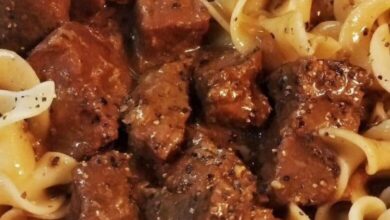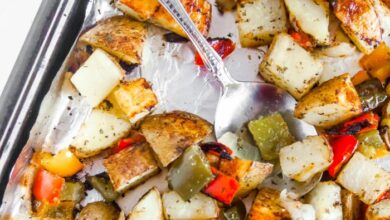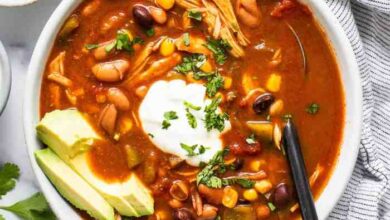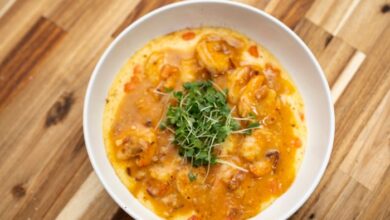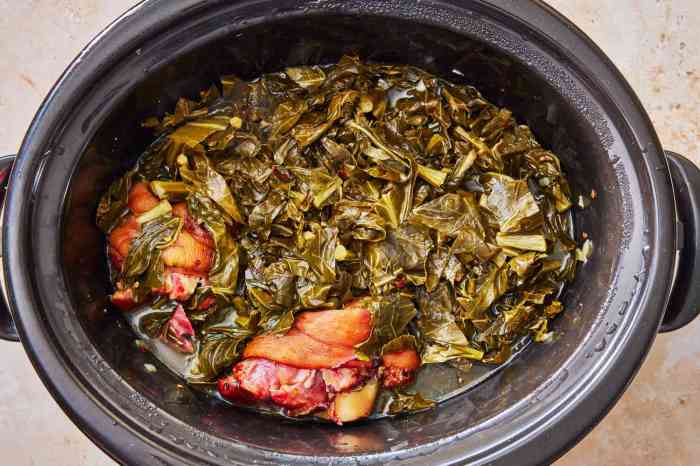
Slow Cooker Collard Greens: A Flavorful and Easy Recipe
Slow cooker collard greens are a true comfort food classic. These leafy greens are packed with vitamins and minerals, making them a nutritious addition to any meal. The slow cooker method allows the collard greens to simmer gently, resulting in tender, flavorful leaves that are perfect for a satisfying and healthy dinner.
I remember my grandma’s slow cooker collard greens, a dish that always filled the house with a comforting aroma and brought our family together around the table.
Collard greens are a versatile ingredient that can be prepared in many ways, but slow cooking is a simple and foolproof method that allows the flavors to meld and develop over time. Whether you prefer a classic Southern-style recipe or a more modern twist, slow cooker collard greens offer a delicious and easy way to enjoy this nutritious vegetable.
Introduction to Slow Cooker Collard Greens
Collard greens are a leafy green vegetable that is a member of the Brassica family, which also includes kale, mustard greens, and cabbage. They are a good source of vitamins A, C, and K, as well as fiber, calcium, and iron.
Collard greens are a versatile vegetable that can be cooked in many ways, but slow cooking is a particularly good method for bringing out their flavor and making them tender.Slow cooking is a gentle and forgiving method of cooking that allows the flavors of the ingredients to meld together.
Collard greens are a hearty vegetable that can withstand long cooking times, and slow cooking allows them to become soft and flavorful without becoming mushy.
Benefits of Slow Cooker Collard Greens
Slow cooking collard greens offers several benefits:
- Flavor:Slow cooking allows the collard greens to develop a rich, savory flavor. The long cooking time allows the greens to release their natural sweetness and absorb the flavors of the other ingredients in the pot.
- Tenderness:Collard greens can be tough and fibrous if they are not cooked properly. Slow cooking breaks down the tough fibers in the greens, making them tender and easy to eat.
- Convenience:Slow cooking is a hands-off method of cooking, which makes it ideal for busy weeknights. Simply add all of the ingredients to the slow cooker, set it, and forget it!
Ingredients and Preparation
The foundation of any great slow cooker collard greens recipe lies in the right ingredients and proper preparation. While the basic recipe is simple, there are variations and substitutions to cater to diverse tastes and dietary needs. Let’s delve into the details.
Slow cooker collard greens are a true comfort food, simmering all day with just a hint of smoky flavor. And while they’re perfect on their own, a little something special can elevate them to another level. For a touch of decadence, try drizzling a spoonful of homemade Irish whiskey cream over your collard greens.
The sweet, creamy richness complements the earthy greens perfectly, creating a taste sensation that’s sure to please.
Essential Ingredients
The essential ingredients for a classic slow cooker collard greens recipe are:
- Collard Greens:The star of the show! Choose fresh, vibrant green collard greens for the best flavor and texture.
- Liquid:Water, chicken broth, or vegetable broth are common choices. The liquid helps tenderize the greens and create a flavorful sauce.
- Fat:Bacon drippings, olive oil, or vegetable oil are used for flavor and to prevent sticking.
- Seasonings:Salt, black pepper, garlic powder, onion powder, and smoked paprika are essential for a flavorful base.
- Other Ingredients:Optional additions include smoked meat (like ham hocks or smoked turkey necks), onions, and vinegar for a tangy kick.
Variations and Substitutions
There are numerous variations and substitutions for those seeking different flavor profiles or dietary needs. Here are some examples:
- Vegan:Replace bacon drippings with olive oil or vegetable oil. Use vegetable broth instead of chicken broth and omit any smoked meat.
- Spicy:Add a pinch of cayenne pepper or a few dashes of hot sauce for a spicy kick.
- Tangy:Increase the amount of vinegar or add a splash of lemon juice for a tangy twist.
- Sweet:Add a touch of brown sugar or molasses for a slightly sweet flavor.
- Hearty:Include diced potatoes, carrots, or other root vegetables for a heartier dish.
Prepping the Collard Greens
Properly prepping the collard greens is crucial for achieving a tender and flavorful dish. Here’s a step-by-step guide:
- Wash:Thoroughly wash the collard greens under cold running water, removing any dirt or debris.
- Remove the Stems:Trim the thick stems from the leaves, as they can be tough to chew.
- Chop:Chop the collard greens into bite-sized pieces. For a smoother texture, you can also tear the leaves into smaller pieces.
Slow Cooker Techniques
Slow cookers offer a convenient and hands-off approach to cooking collard greens. They allow the greens to simmer gently, resulting in tender, flavorful leaves. Understanding the different settings and techniques for using a slow cooker can help you achieve the perfect texture and taste.
Slow cooker collard greens are a staple in my kitchen, especially during the colder months. They’re so easy to make, just toss them in the slow cooker with some broth and seasonings, and let them simmer all day. But when summer rolls around, I crave something lighter and brighter.
That’s when I turn to a perfect summer fruit salad with juicy watermelon, sweet berries, and tangy citrus. It’s the perfect way to cool down and enjoy the bounty of the season. Then, when the days start to get shorter, I’ll be back to my slow cooker collard greens, a comforting reminder of the warmth and simplicity of home cooking.
Slow Cooker Settings
Slow cookers typically have two or three settings: low, high, and sometimes a warm setting. The low setting cooks food at a lower temperature, while the high setting cooks food at a higher temperature. The warm setting maintains the food at a safe temperature for serving.
- The low setting is ideal for long, slow cooking, like for collard greens. It allows the greens to simmer gently and break down their tough fibers, resulting in a tender and flavorful dish.
- The high setting cooks food more quickly, but it can also lead to overcooked or dry greens. It is best to use the high setting for shorter cooking times or when you need to cook the greens more quickly.
- The warm setting is perfect for keeping cooked collard greens warm and ready to serve.
Preparing Slow Cooker Collard Greens
Here is a step-by-step guide for preparing slow cooker collard greens:
- Wash and trim the collard greens. Remove the tough stems and any wilted or damaged leaves. Chop the leaves into bite-sized pieces.
- Add the collard greens to the slow cooker. You can add the greens in layers or all at once, depending on your preference.
- Add your chosen liquid. Water, broth, or stock can be used to add flavor and moisture to the collard greens. The amount of liquid will depend on the size of your slow cooker and the amount of collard greens you are using.
- Season the collard greens. Add salt, pepper, and any other desired seasonings. Popular seasonings include garlic, onion, smoked paprika, and hot sauce.
- Cook on low for 6-8 hours, or on high for 3-4 hours. The cooking time will vary depending on the size and thickness of the collard greens.
- Stir the collard greens occasionally during cooking. This helps ensure even cooking and prevents the greens from sticking to the bottom of the slow cooker.
- Adjust the seasonings to taste before serving. You may need to add more salt, pepper, or other seasonings to achieve the desired flavor.
Adding Liquid
The choice of liquid for slow cooker collard greens can significantly impact the flavor and texture of the final dish.
Slow cooker collard greens are a classic comfort food, and I love how they simmer all day, developing deep flavor. The best part? They’re perfect for a meal prep session, and you can pair them with a light and refreshing soup like this garden fresh tomato soup for a balanced and satisfying meal.
Of course, if you’re craving something a little richer, you can always top your collards with a dollop of smoked paprika mayo for a bit of extra flavor.
- Water: Water is the most basic option and provides a neutral base for the collard greens to cook in. It is a good choice if you want to keep the flavor of the collard greens simple.
- Broth: Broth adds flavor and richness to the collard greens. Chicken broth is a popular choice, but vegetable broth, beef broth, or even seafood broth can be used. The type of broth you choose will influence the flavor of the final dish.
- Stock: Stock is similar to broth, but it is made by simmering bones and vegetables for a longer period. This process extracts more flavor and nutrients from the ingredients, resulting in a richer and more complex flavor. Stock can be used in place of broth to add depth and complexity to your collard greens.
Flavor Enhancements
Collard greens are a blank canvas for flavor, and with a little creativity, you can transform them into a culinary masterpiece. There are countless ways to elevate their taste, from classic seasonings to unexpected additions.
Seasoning Options
Seasonings play a crucial role in enhancing the flavor of collard greens.
- Salt and Pepper:These are the foundation of any seasoning blend, balancing the bitterness of the greens and providing a savory base.
- Garlic Powder:Adds a pungent and earthy aroma, complementing the greens’ inherent flavor.
- Onion Powder:Offers a subtle sweetness and savory depth that enhances the overall taste.
- Smoked Paprika:Infuses a smoky and slightly sweet flavor, creating a warm and complex profile.
- Cayenne Pepper:Adds a touch of heat, balancing the richness of the greens and creating a more vibrant flavor.
- Red Pepper Flakes:Provide a gentle heat and a hint of sweetness, adding complexity without overpowering the greens.
- Black Peppercorns:Offer a sharp and peppery kick, adding a contrasting note to the earthy greens.
- Dried Thyme:Adds a subtle, earthy, and slightly lemony flavor that complements the greens’ texture.
- Dried Oregano:Provides a slightly bitter and earthy flavor, enhancing the savory depth of the greens.
Flavorful Additions
Adding ingredients like smoked meats, onions, garlic, or peppers can significantly enhance the flavor profile of collard greens.
- Smoked Meats:Smoked turkey, ham hocks, or bacon impart a rich, smoky flavor that infuses the greens with a deep savory depth.
- Onions:Adding chopped onions, whether white, yellow, or red, adds a subtle sweetness and a pungent aroma that complements the greens’ texture.
- Garlic:Fresh garlic cloves, minced or crushed, add a potent and earthy flavor that enhances the savory notes of the greens.
- Peppers:Incorporating bell peppers, jalapenos, or habaneros adds a vibrant color, a subtle sweetness, and a touch of heat, depending on the pepper variety.
Flavor Profiles and Ingredient Combinations
| Flavor Profile | Ingredient Combinations |
|---|---|
| Classic Savory | Salt, pepper, garlic powder, onion powder, smoked turkey |
| Smoky and Spicy | Smoked paprika, cayenne pepper, smoked ham hocks, red pepper flakes |
| Sweet and Earthy | Onion powder, garlic powder, dried thyme, dried oregano, smoked bacon |
| Tangy and Zesty | Apple cider vinegar, lemon juice, red pepper flakes, smoked turkey |
| Spicy and Savory | Cayenne pepper, jalapeno peppers, garlic powder, smoked ham hocks |
Serving and Presentation: Slow Cooker Collard Greens
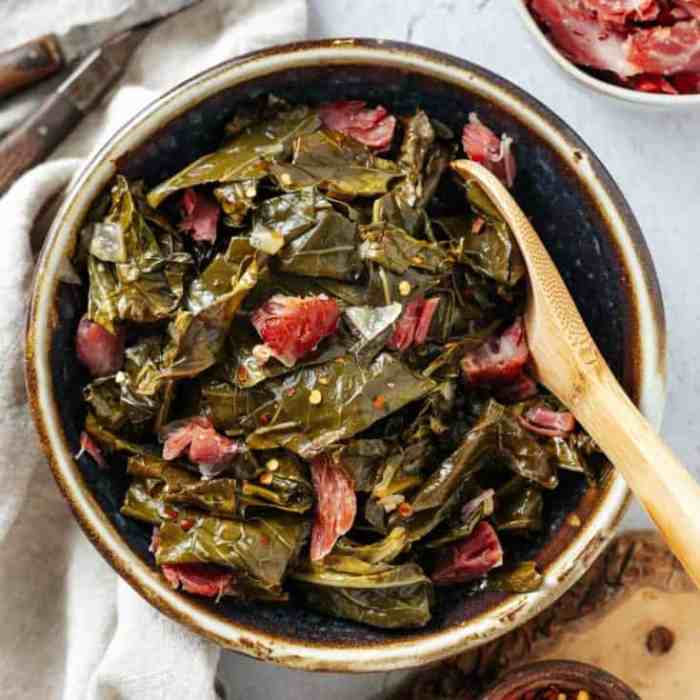
Slow cooker collard greens are a versatile dish that can be served in a variety of ways. Whether you’re looking for a traditional approach or something more creative, there are endless possibilities for serving and presenting this comforting side dish.
Traditional Serving
Collard greens are traditionally served as a side dish, often accompanying barbecue, fried chicken, or pork chops. They are typically served warm, with a generous portion of the cooking liquid spooned over the top.
- Accompanying Dishes:Cornbread, macaroni and cheese, baked beans, potato salad, and coleslaw are all popular side dishes to serve alongside collard greens.
- Regional Variations:In the Southern United States, collard greens are often served with a side of vinegar and hot sauce for dipping.
Creative Garnishes and Enhancements
While collard greens are delicious on their own, adding a few garnishes can elevate their visual appeal and enhance their flavor.
- Fresh Herbs:Chopped parsley, cilantro, or chives can add a burst of freshness and color.
- Citrus Zest:A sprinkle of lemon or orange zest can add a bright and tangy note.
- Toasted Nuts:Toasted pecans or walnuts provide a crunchy texture and nutty flavor.
- Crispy Fried Onions:A handful of crispy fried onions adds a satisfying crunch and a savory element.
- Red Pepper Flakes:For a touch of heat, sprinkle a pinch of red pepper flakes over the greens.
Leftover Collard Greens
Leftover collard greens can be used in a variety of ways. They can be added to soups, stews, or chilis for extra flavor and nutrients. They can also be used as a filling for sandwiches, wraps, or tacos.
- Collard Green Soup:Blend leftover collard greens with vegetable broth, onions, and spices for a hearty and nutritious soup.
- Collard Green Quesadillas:Layer leftover collard greens with cheese and your favorite fillings in a tortilla and grill until golden brown.
- Collard Green Salad:Chop leftover collard greens and combine them with other salad ingredients for a unique and flavorful salad.
Variations and Innovations
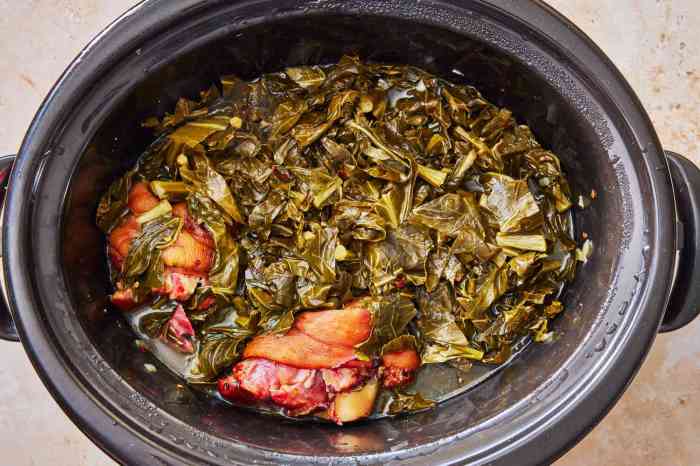
Collard greens, a staple in Southern cuisine, offer a canvas for culinary creativity. Beyond the traditional slow-cooked method, exploring different cultural influences and dietary needs can unlock a world of flavorful variations.
Cultural Influences
Collard greens are enjoyed globally, each region infusing its unique flavors and techniques.
- Southern United States:The classic slow-cooked collard greens with smoked meat, often pork, are a hallmark of Southern cooking. The long cooking time allows the greens to soften and develop a rich, earthy flavor.
- West African:In West Africa, collard greens are often cooked with peanuts, palm oil, and spices like ginger, garlic, and cayenne pepper. This creates a flavorful and hearty dish.
- Caribbean:Caribbean cuisine incorporates collard greens into stews and rice dishes, using coconut milk, spices like allspice and thyme, and often seafood for a unique flavor profile.
Dietary Modifications
Collard greens are naturally vegetarian and can be easily adapted for vegan and gluten-free diets.
| Dietary Restriction | Modifications | Example |
|---|---|---|
| Vegetarian | Use vegetable broth or water instead of meat-based broth. | Slow-cooked collard greens with vegetable broth, smoked paprika, and garlic. |
| Vegan | Omit any animal products, including meat, dairy, and eggs. Use vegan broth or water. | Slow-cooked collard greens with vegan broth, smoked tofu, and nutritional yeast for a cheesy flavor. |
| Gluten-Free | Ensure all ingredients, including broth and seasonings, are gluten-free. | Slow-cooked collard greens with gluten-free broth, smoked turkey, and a sprinkle of gluten-free smoked paprika. |
Collard Green Soup
A hearty and flavorful soup, featuring collard greens as the primary ingredient, can be prepared in the slow cooker.
Ingredients:
- 1 tablespoon olive oil
- 1 onion, chopped
- 2 cloves garlic, minced
- 1 (14.5 ounce) can diced tomatoes, undrained
- 4 cups vegetable broth
- 1 (10 ounce) package frozen chopped collard greens, thawed and drained
- 1/2 teaspoon salt
- 1/4 teaspoon black pepper
- 1/4 cup chopped fresh parsley
Instructions:
- In the slow cooker, sauté the onion and garlic in olive oil until softened.
- Add the diced tomatoes, vegetable broth, collard greens, salt, and pepper.
- Cook on low for 6-8 hours, or until the collard greens are tender.
- Stir in the parsley before serving.

